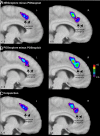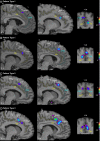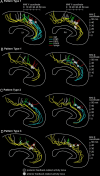The location of feedback-related activity in the midcingulate cortex is predicted by local morphology
- PMID: 23365257
- PMCID: PMC6619107
- DOI: 10.1523/JNEUROSCI.2779-12.2013
The location of feedback-related activity in the midcingulate cortex is predicted by local morphology
Abstract
Information processing in the medial frontal cortex is often said to be modulated in pathological conditions or by individual traits. This has been observed in neuroimaging and event-related potential studies centered in particular on midcingulate cortex (MCC) functions. This region of the brain is characterized by considerable intersubject morphological variability. Whereas in a subset of hemispheres only a single cingulate sulcus (cgs) is present, a majority of hemispheres exhibit an additional sulcus referred to as the paracingulate sulcus (pcgs). The present functional magnetic resonance imaging study defined the relationship between the local morphology of the cingulate/paracingulate sulcal complex and feedback-related activity. Human subjects performed a trial-and-error learning task in which they had to discover which one of a set of abstract stimuli was the best option. Feedback was provided by means of fruit juice, as in studies with monkeys. A subject-by-subject analysis revealed that the feedback-related activity during exploration was systematically located in the cgs when no pcgs was observed, but in the pcgs when the latter sulcus was present. The activations had the same functional signature when located in either the cgs or in the pcgs, confirming that both regions were homologues. Together, the results show that the location of feedback-related MCC activity can be predicted from morphological features of the cingulate/paracingulate complex.
Figures






References
-
- Amiez C, Petrides M. Feedback valuation processing within the prefrontal cortex. In: Dreher JC, Tremblay L, editors. Handbook of reward and decision making. New York: Elsevier; 2009. pp. 213–228.
-
- Amiez C, Kostopoulos P, Champod AS, Collins DL, Doyon J, Del Maestro R, Petrides M. Preoperative functional magnetic resonance imaging assessment of higher-order cognitive function in patients undergoing surgery for brain tumors. J Neurosurg. 2008;108:258–268. - PubMed
Publication types
MeSH terms
LinkOut - more resources
Full Text Sources
Other Literature Sources
